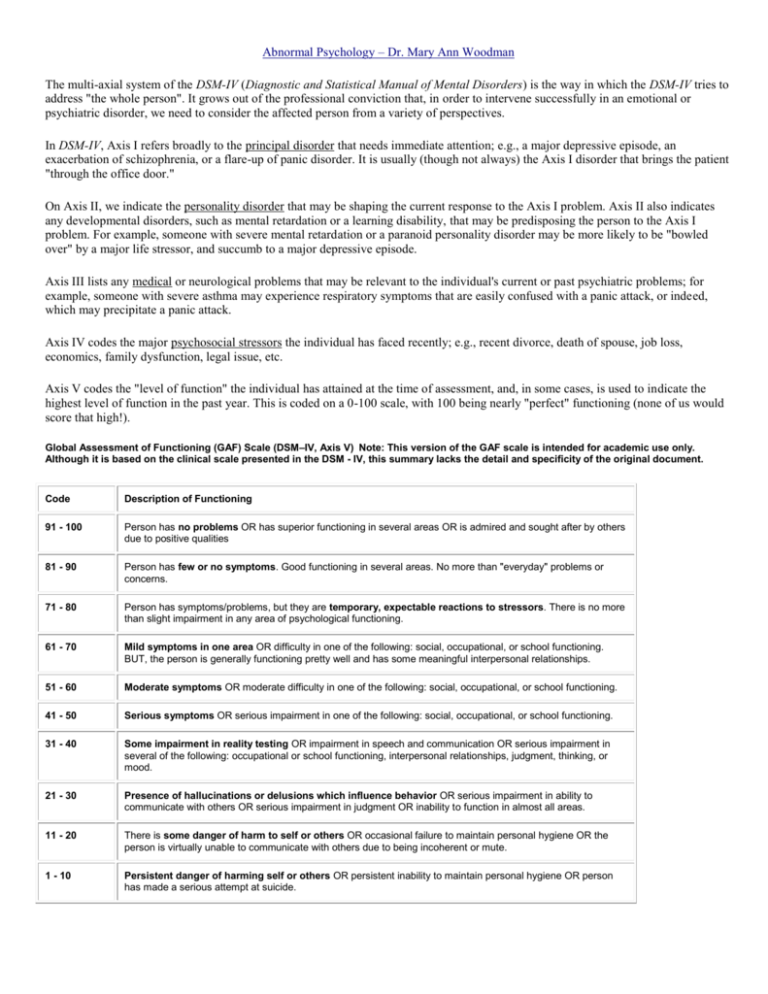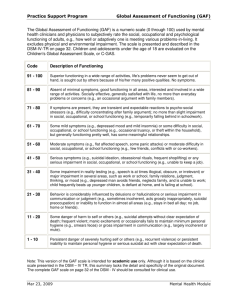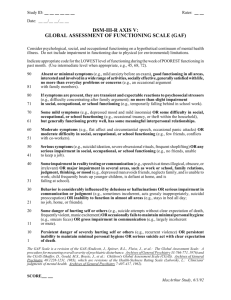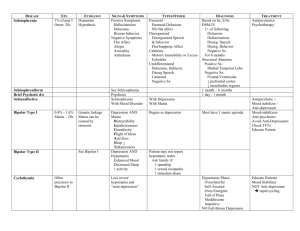DSM-IV Multi-Axial System & GAF Scale | Abnormal Psychology
advertisement

Abnormal Psychology – Dr. Mary Ann Woodman The multi-axial system of the DSM-IV (Diagnostic and Statistical Manual of Mental Disorders) is the way in which the DSM-IV tries to address "the whole person". It grows out of the professional conviction that, in order to intervene successfully in an emotional or psychiatric disorder, we need to consider the affected person from a variety of perspectives. In DSM-IV, Axis I refers broadly to the principal disorder that needs immediate attention; e.g., a major depressive episode, an exacerbation of schizophrenia, or a flare-up of panic disorder. It is usually (though not always) the Axis I disorder that brings the patient "through the office door." On Axis II, we indicate the personality disorder that may be shaping the current response to the Axis I problem. Axis II also indicates any developmental disorders, such as mental retardation or a learning disability, that may be predisposing the person to the Axis I problem. For example, someone with severe mental retardation or a paranoid personality disorder may be more likely to be "bowled over" by a major life stressor, and succumb to a major depressive episode. Axis III lists any medical or neurological problems that may be relevant to the individual's current or past psychiatric problems; for example, someone with severe asthma may experience respiratory symptoms that are easily confused with a panic attack, or indeed, which may precipitate a panic attack. Axis IV codes the major psychosocial stressors the individual has faced recently; e.g., recent divorce, death of spouse, job loss, economics, family dysfunction, legal issue, etc. Axis V codes the "level of function" the individual has attained at the time of assessment, and, in some cases, is used to indicate the highest level of function in the past year. This is coded on a 0-100 scale, with 100 being nearly "perfect" functioning (none of us would score that high!). Global Assessment of Functioning (GAF) Scale (DSM–IV, Axis V) Note: This version of the GAF scale is intended for academic use only. Although it is based on the clinical scale presented in the DSM - IV, this summary lacks the detail and specificity of the original document. Code Description of Functioning 91 - 100 Person has no problems OR has superior functioning in several areas OR is admired and sought after by others due to positive qualities 81 - 90 Person has few or no symptoms. Good functioning in several areas. No more than "everyday" problems or concerns. 71 - 80 Person has symptoms/problems, but they are temporary, expectable reactions to stressors. There is no more than slight impairment in any area of psychological functioning. 61 - 70 Mild symptoms in one area OR difficulty in one of the following: social, occupational, or school functioning. BUT, the person is generally functioning pretty well and has some meaningful interpersonal relationships. 51 - 60 Moderate symptoms OR moderate difficulty in one of the following: social, occupational, or school functioning. 41 - 50 Serious symptoms OR serious impairment in one of the following: social, occupational, or school functioning. 31 - 40 Some impairment in reality testing OR impairment in speech and communication OR serious impairment in several of the following: occupational or school functioning, interpersonal relationships, judgment, thinking, or mood. 21 - 30 Presence of hallucinations or delusions which influence behavior OR serious impairment in ability to communicate with others OR serious impairment in judgment OR inability to function in almost all areas. 11 - 20 There is some danger of harm to self or others OR occasional failure to maintain personal hygiene OR the person is virtually unable to communicate with others due to being incoherent or mute. 1 - 10 Persistent danger of harming self or others OR persistent inability to maintain personal hygiene OR person has made a serious attempt at suicide.








